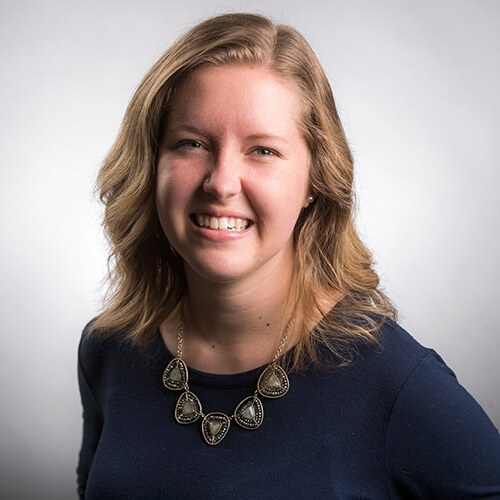The Lead is a weekly newsletter that provides resources and connections for student journalists in both college and high school. Sign up here to have it delivered to your inbox every Wednesday morning during the school year.
The pandemic upended student newspapers’ routines and audiences in 2020, forcing them to rethink the best way to get news to readers who were no longer coming to school in person.
Two student journalists and the author of this newsletter reflect on the lessons they learned from the pandemic and how their publications have adapted now that students are in school in person again.
The Quadrangle
Manhattan College, New York
The Quadrangle was excited to publish in print again when students returned to campus.
The newspaper stopped its print publication while students were away from campus between March and August 2020, managing editor and features editor Jilleen Barrett said. Print publication resumed in fall 2020, but significant budget cuts decimated the newspaper’s print budget by fall 2021.
“This made the news much less accessible — much of our readership includes professors who are inclined to pick up a copy of the paper when they see them distributed across campus,” Barrett said.
The publication produced two physical copies of the paper in fall 2021 but focused more on promoting stories on social media. The Quadrangle uses Instagram and Twitter to promote individual stories and share live coverage from basketball games.
“Student audiences have responded well to this strategy, which showed the whole staff that print issues and online issues alike are necessary when it comes to properly reporting news to the community as a whole,” Barrett said.
The Beak
Greenwich High School, Connecticut
COVID-19 pushed The Beak to experiment with new platforms, like podcasts and social media.
“The pandemic truly hindered my publication’s efforts to continue writing issues and keep members engaged in the virtual meetings,” staff writer Shreya Prabhu said.
The newspaper lost some staff members and paused its print publication. Instead, it focused on revamping its website and also started a podcast, The Feed. It posted each new story on Instagram in lieu of print publication.
“The most effective way to get news to readers is by finding a medium which they will use and reaching them from there,” Prabhu said. “For us, that was Instagram.”
Taylor Blatchford, The Lead
Poynter newsletter
COVID-19 didn’t change my publishing platforms in the same way as these other publications. As an email newsletter, I didn’t have to make changes to a print publication or focus more closely on online distribution. It did help me consider how to cover huge topics from multiple angles and structure the newsletter thematically.
The biggest adjustment early in the pandemic was just how quickly the news moved. One week in early March 2020, I thought a newsletter issue related to the coronavirus would be too niche — only a few schools had reported cases at that point. The following week, it was clear that this was a national story affecting nearly every school and student newsroom.
I couldn’t keep track of all the breaking news updates across universities and student publications. I’m one person who writes The Lead as a side project, not a full-time job. The way I could be most helpful for students, I realized, was by providing them resources, story ideas and examples of what other student newsrooms were doing exceptionally well. I hoped to give student newsrooms a way to zoom out and consider what they could be doing differently.
The first coronavirus issue of The Lead was a resource guide that featured examples of student coverage. In the following months, The Lead featured student papers’ decisions on printing physical issues, graduation coverage, public records requests to help coronavirus reporting, a pandemic photo project and forward-looking pandemic story ideas.
Covering an issue as huge as COVID-19 forced me to think thematically and break large topics down into focused newsletter issues. Just like it’s hard to write one all-encompassing newsletter issue about a global pandemic, it’s hard to write one about sports, or ethics, or editing. Thinking about big topics from different angles (that translate into specific newsletter issues) is an approach I’ve kept this past school year and plan to continue with moving forward.
More from this series
This newsletter issue is part of an ongoing series about platforms and news distribution. Previous issues:
- How one newsroom embraced digital-first publishing and doubled its audience
- Where’s your audience? Most of them aren’t reading print
What could your professors be doing better?
I especially enjoyed this week’s issue of Alma Matters, Poynter’s newsletter for journalism educators. During a college class visit at Cal State Northridge, Barbara Allen (Poynter’s director of college programming, and my editor!) asked students what they’d truly registered so far in journalism school and what they wish their professors were better at.
The answers are enlightening and thought-provoking. I know there are teachers and advisers who read this newsletter — consider turning the tables and asking your students for feedback and letting them shape their own education.
One story worth reading
We’ve all seen journalists refer to themselves as “storytellers” in their social media bios; you may have used the term yourself. A new study from the University of Cincinnati, however, shows that the term leaves a bad impression with the public, Sarah Scire writes for Nieman Lab.
Some survey respondents said, “Storyteller to me sounds like a well-trained liar” and, “It makes me feel like they will make up a story. Like a tale.” It may feel unnecessarily semantic to debate how journalists should refer to themselves on Twitter or LinkedIn, but in a climate where mistrust of media is still rampant, even the little things matter.
Opportunities and trainings
- Apply for scholarships from the National Press Club by March 18.
- High school seniors, consider applying for your state’s Journalist of the Year contest this spring. Deadlines vary by state.
- Apply for the Global Press Freedom Advocacy Institute, a six-week online program for student journalists hosted by the Student Press Law Center and PEN America.
- Apply for the NABJ student multimedia project by March 28 for a chance to cover the yearly conference in August.
- Register for ONA’s free career day event, to be held virtually March 31.
- Register for the JEA/NSPA National High School Journalism Convention, to be held in Los Angeles April 7-9.
- High school students, enter The New York Times’ student editorial contest by April 13.









